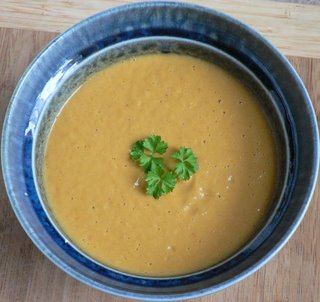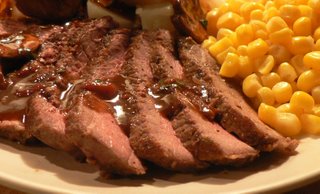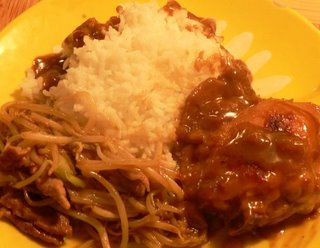Roast: Beef Eye Round
 The eye round roast is fabricated from the primal called the round. Primals are large, standardized cuts of meat take from the carcass. Since bovine are so large we generally don't use a whole primal but cut it down into smaller cuts; this process is called fabrication. These smaller cuts are not standardized per se but many are in general use.
The eye round roast is fabricated from the primal called the round. Primals are large, standardized cuts of meat take from the carcass. Since bovine are so large we generally don't use a whole primal but cut it down into smaller cuts; this process is called fabrication. These smaller cuts are not standardized per se but many are in general use.The round is essentially the bovine's back leg. Cuts from the round are generally thought of as tough (and cheap). The rule of thumb is that the closer the cut is to areas of work the more connective tissue and flavour it has. Connective tissue connects muscles to each other and to bone. The cut I bought is called the eye, which is a long muscle in the leg.
As you can see from the photo the meat has large fibers, one obstacal in creating a tender dish. Cuts from the round don't have to end up tough, the cook simply needs to account for it's needs. Meat with high connective tissue benefit from certain methods of cooking; braising, slow roasting & stewing. This meat would also be good in stir fry taking advantage of marination.
Tonight's challenge was slow roasting. The method I used is based upon several sources: Cooks Illustrated, Good Eats, my text book On Cooking 3rd Ed. and another book called La Varenne. I'll tell you now that I had mixed results; encouraging but it could have been better. I found that the meat had good flavour and was fairly tender if cut very thin otherwise it was tough.
Ingredients:
Salt & Pepper to taste
1-2 T fat
~1 C Mirepoix, medium dice
~⅓ C Red Wine
~1 C Stock
- Preheat oven to 250°F.
- Season roast with salt and pepper as desired. Don't skimp on the salt.
- Brown the roast in some fat over medium high heat. Use olive oil, vegetable oil or mixed with some butter. The pan should be heavy-ish, conforms to the roast (not too big otherwise the fond will burn) but not too small (the roast shouldn't press the sides).
- Remove the roast and put the mirepoix in the bottom, rest the roast on top.
- Cook the roast in the oven until 110°F internal; about 45-60 minutes.
- Increase the oven's temperature to 500°F and cook the roast to 130°F internal; about 15 minutes.
- Remove the roast from the oven, set the roast aside to sit for 20 minutes. This allows the juices inside the roast to redistribute evenly throughout the meat.
- During this time put the pan over medium high heat. Add the wine and scrap up all the little brown pieces, dissolving them (this is known as deglazing).
- Cook the wine down until it is almost gone, about 3 minutes.
- Add the stock, bring to a simmer and reduce for another 5 minutes or to desired consistency. Strain.
- Slice the meat quite thing, no more than 3 mm.
- Serve.











